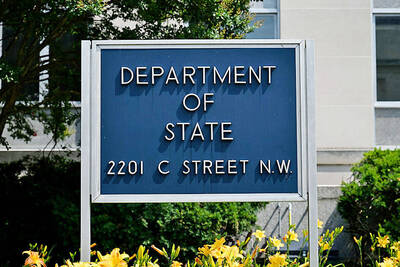The president of the US-Taiwan Business Council yesterday confirmed a report in a US-based defense magazine that the US State Department had frozen US congressional notifications for new arms sales to Taiwan “until at least spring next year.”
Citing sources in Taipei and Washington, Defense News on Monday wrote that the suspension was the direct result of “effective lobbying by Beijing.”
“The Chinese are ramping up the pressure and engaging us in disinformation to complicate our review, particularly in the context of a vulnerable process for arms sales,” a defense analyst in Washington told the magazine.
US-Taiwan Business Council president Rupert Hammond-Chambers told the Taipei Times that so far, three notifications had been frozen, with more expected to “stack up” as the year progresses. He said the freeze has been in force for “at least a month,” but would not confirm the content of the notifications.
A multibillion-dollar program to upgrade Taiwan’s aging F-16A/B fighter aircraft is not included in the freeze, as the program has yet to enter the notification stage. However, as Beijing regards this program as an arms sale, Hammond-Chambers said he expected notification, which is months away, to face similar pressure. He said he was not aware of other notifications scheduled for this year.
Plans to acquire more advanced F-16C/Ds — which have become a “red line” for Beijing — have been on hold since 2006.
“Washington is as vulnerable as it’s ever been to pressure by Beijing since the switch in diplomatic relations in 1979, and this has raised Beijing’s willingness to pressure Washington,” he told the Taipei Times.
With the US hosting the APEC summit next year, contact between US and Chinese officials will increase and create more opportunities for China to exert pressure on the administration of US President Barack Obama, he said.
The stacking-up of notifications, which would result in multibillion-dollar packages, he said, also compels Beijing to turn up the rhetoric.
“I have never seen the US have so little ambition in the Taiwan Strait,” he said, adding that it was essential to have balance in the strait, with Taipei engaging both Beijing and Washington in a “sustainable” fashion.
If that triangular relationship gets out of balance, it becomes “inherently destabilizing in the long term,” he said, alluding to Washington’s failure to counterbalance the just-signed Economic Cooperation Framework Agreement (ECFA) between Taiwan and China.
While the retaliatory risks from Beijing remain ambiguous and uncertain, Washington is taking them seriously and as a consequence arms sales have been frozen for this year, Hammond-Chambers said.
“It is difficult to conceive the Obama administration releasing anything this year,” he said.
Asked for comment yesterday, Premier Wu Den-yih (吳敦義) said he had no information on the matter and would ask government agencies to look into it. Wu said Taipei would proceed with planned procurement requests and continue to negotiate with the US.
Minister of Foreign Affairs Timothy Yang (楊進添) said by telephone that he had yet to read the report and would look into the matter.
The American Institution in Taiwan was unavailable for comment.
ADDITIONAL REPORTING BY SHIH HSIU-CHUAN

A car bomb killed a senior Russian general in southern Moscow yesterday morning, the latest high-profile army figure to be blown up in a blast that came just hours after Russian and Ukrainian delegates held separate talks in Miami on a plan to end the war. Kyiv has not commented on the incident, but Russian investigators said they were probing whether the blast was “linked” to “Ukrainian special forces.” The attack was similar to other assassinations of generals and pro-war figures that have either been claimed, or are widely believed to have been orchestrated, by Ukraine. Russian Lieutenant General Fanil Sarvarov, 56, head

SAFETY FIRST: Double the number of police were deployed at the Taipei Marathon, while other cities released plans to bolster public event safety Authorities across Taiwan have stepped up security measures ahead of Christmas and New Year events, following a knife and smoke bomb attack in Taipei on Friday that left four people dead and 11 injured. In a bid to prevent potential copycat incidents, police deployments have been expanded for large gatherings, transport hubs, and other crowded public spaces, according to official statements from police and city authorities. Taipei Mayor Chiang Wan-an (蔣萬安) said the city has “comprehensively raised security readiness” in crowded areas, increased police deployments with armed officers, and intensified patrols during weekends and nighttime hours. For large-scale events, security checkpoints and explosives

PUBLIC SAFETY: The premier said that security would be tightened in transport hubs, while President Lai commended the public for their bravery The government is to deploy more police, including rapid response units, in crowded public areas to ensure a swift response to any threats, President William Lai (賴清德) said yesterday after a knife attack killed three people and injured 11 in Taipei the previous day. Lai made the remarks following a briefing by the National Police Agency on the progress of the investigation, saying that the attack underscored the importance of cooperation in public security between the central and local governments. The attack unfolded in the early evening on Friday around Taipei Main Station’s M7 exit and later near the Taipei MRT’s Zhongshan

REBUFFED: In response to Chinese criticism over recent arms sales, Washington urged Beijing to engage in meaningful dialogue instead of threats and intimidation Washington’s long-term commitment to Taiwan would not change, the US Department of State said yesterday, urging Beijing to stop pressuring Taiwan and engage in meaningful bilateral dialogues. The remarks came in response to a backlash from Beijing about Washington’s latest approval of arms sales to Taiwan. The US Defense Security Cooperation Agency said in a statement on Wednesday that the Taipei Economic and Cultural Representative Office in the US has asked to purchase an arms package, including Tactical Mission Network Software; AH-1W helicopter spare and repair parts; M109A7 self-propelled howitzers; HIMARS long range precision strike systems; tube-launched, optically tracked, wire-guided missiles; Javelin